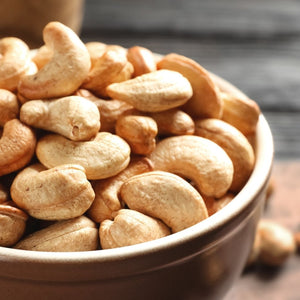No matter what form you choose, nuts are an excellent source of nutrients, protein, and fiber. Because of their nutritional content, there are many health benefits of eating nuts, like lowering cholesterol and even helping to prevent chronic diseases like cancer and diabetes.
While you can incorporate them into your diet in an endless number of ways, some might wonder which is better, raw versus roasted nuts: what’s the difference? We explore the benefits of both types in this blog.
Difference Between Raw and Roasted
The main difference between raw and roasted nuts is the texture. The texture difference is due to roasted nuts undergoing oven-roasting, sometimes called dry-heating. Frying is also an option instead of roasting if you roast raw nuts at home.
Usually, roasting has one of two methods: dry or oil roasting. Roasting affects the fat content of nuts differently. While roasting increases the fat content of almost all nuts, only the pistachio retains the same number of fatty acids.
Raw nuts, however, are not cooked. However, the USDA requires the pasteurization of raw nuts before packaging to prevent Salmonella outbreaks. Roasted nuts do not need to undergo pasteurization since the process would eliminate any pathogens during roasting.
Pasteurization
Nut producers and farmers can choose between two pasteurization methods: they can use steam or fumigate their crops with a chemical called propylene oxide (PPO). Even though both ways are deemed safe by the USDA, the CDC warns that PPO might be a carcinogen.
Typically, larger producers use PPO for pasteurization, while smaller farms usually choose steam, but the method is up to the producer or farmer. Steam pasteurization takes more time than PPO, but it is a more natural technique. Usually, there are no taste differences between steam or PPO.
While pasteurization doesn’t affect raw nuts’ taste or nutritional content, there are taste and health variations between raw and roasted nuts. Depending on your diet needs, learning the pros and cons of both can help you decide which is more suitable for you.
Pros of Raw Nuts
Since raw nuts do not go through roasting, they have more nutrients than roasted, specifically vitamin E and antioxidants.
Even though raw nuts might not have the satisfying crunch or full flavor of roasted nuts, they will have less sodium and fewer free radicals. Free radicals are molecules that have the capability of damaging cells, causing illness and aging.
If you’re incorporating nuts into your diet for weight loss, raw nuts contain less fat content, making them a better choice instead of roasted. Beware: raw nuts are harder to digest, causing bloating and other indigestion symptoms. Luckily, you can make them more digestible!
Soaking Raw Nuts
Instead of roasting, soaking raw nuts can make them easier on your stomach.
Some naturally occurring enzymes and acids in nuts are broken down during the roasting process making roasted nuts more digestible. To make raw nuts easier to eat, always chew them well and eat in moderation.
Soaking them helps break down the indigestible elements. This process tricks the nut into beginning the germination process, breaking down the enzymes and acids. Not only that, but it also dilutes the tannins of the nuts, making them less bitter and more palatable.
Most recipes call for soaking raw nuts overnight or for eight to 10 hours in salt water to give them the digestible qualities of roasted nuts.
Pros of Roasted Nuts
Overall, roasted nuts have a more appealing texture and enhanced flavor. Thanks to the roasting process, they are easier to digest and have a lower risk of food-borne illnesses than pasteurized raw nuts.
But the roasting process does have some drawbacks. When the process exposes nuts to heat, they lose water and increase their fat content, sometimes with trace amounts of trans fats. The sodium content also increases—which is why they are so tasty—and can also increase exposure to carcinogens when eaten in large quantities.
Remember that roasted nuts are still a healthy addition to your diet and provide a wealth of nutrients and disease-fighting antioxidants. Any food exposed to high heat in roasting will see increases in sodium and possible carcinogenic exposure. So, what exactly is the roasting process?
Roasting Processes
The roasting process changes the proteins within the nuts, altering the flavor.
Nut farmers and larger producers can choose between two methods of roasting: dry roasting or oil roasting. Oil roasting, of course, involves oil and dry roasting depends solely on heat. Also, you can roast nuts at home in the same manner—in the oven or on your stovetop.
Learn more about the two methods to decide how you can implement them in any of your recipes or as a snack:
- Dry Roasting: Dry roasting is applying heat to food products without oil or even water. Stirring is necessary during the process; this ensures you evenly expose every nut to the heat. If you’re at-home dry roasting, you can use a frying pan, wok, coffee roaster, or convection oven.
- Oil Roasting: Oil roasting is the application of heat but with oil to ensure even distribution. Any oil will do, such as olive, canola, or even avocado oil. Pay attention to the different smoke points that each oil offers. The higher the smoke point, the easier the nuts will burn.
If you choose to roast nuts at home, some nuts will cook faster than others. Softer nuts like pecans, walnuts, and pistachios will typically cook faster than almonds, hazelnuts, or peanuts. Choose a corresponding oil for each type: for example, almonds will roast better with higher smoke point oils like avocado or high-quality olive oil.
Which Is Better?
Overall, there aren’t that many differences between raw versus roasted nuts. “What’s the difference” doesn’t matter so much as “what’s your preference?”
Raw is an excellent choice if you’re looking for the most nutrients but are okay with less flavor. But if you’re less concerned with the health aspects and more interested in the best flavor, consider roasted nuts your go-to. Either way, incorporating more nuts into your diet will add more nutrients and health benefits—while making snacks and recipes more satisfying!
Don’t forget that nuts make a great gift, too! You can support small farmers when you buy pistachios online from Sohnrey Family Foods! Choosing a local farm over a mass producer gives you better quality while supporting your community!



Emerald - January 20, 2025
My challenge is that I don’t want to lose weight and as well, wants to get all the health benefits.
Alex - October 01, 2024
Podrias explucarme por favor porque tostar las nuecez presenta exposicion cancerigena
Krishnam - August 06, 2024
Before reading your blog, I was regularly eating 100g/day raw peanuts, I regularly faced gas issue, than I had to cut my diet which is a bad thing as I want to gain weight.
May soaking peanuts will help.
Ed - October 20, 2023
Thanks for the information. I’ve wondered about this for years.
Lois Sibley - September 09, 2023
This is wonderful information. Thank you so much.
Sarah - February 15, 2023
Very informative little article. Thank u
Lynn - November 20, 2022
Great article! Definitely the information I was looking for and more.